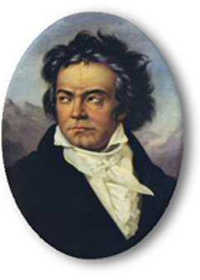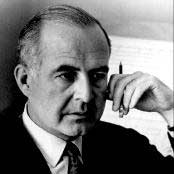| OPENING NIGHT GALA WITH GARRICK OHLSSON | ||||||||||
Overture to Fidelio Beethoven's only opera, Fidelio, underwent numerous major revisions by the composer before he arrived at the final version we know today. The overture to the opera underwent even greater transformations. There are four different overtures, all of them popular in the concert hall. The first three are called Leonore (Nos.1, 2 and 3), after the original title of the opera, and the fourth is known as Fidelio, Beethoven's final title. The complex plot is a paean to marital fidelity and political justice. Leonore disguises herself as a young man, Fidelio, in order to free her husband Florestan who has been incarcerated unjustly as a political prisoner. Beethoven's difficulties with the earlier versions (the three Leonore overtures) stemmed from the fact that they were too dramatic and explicit, and thus giving away the most dramatic and exciting moments of the opera. The final version, the Fidelio overture, is neither very dramatic nor very closely related to the opera itself. In that sense it could be called a generic overture, similar to many of Rossini's. However, being by Beethoven, it is nevertheless a well-crafted and enjoyable – if somewhat lightweight – composition. By the nineteenth century, opera overtures were generally constructed in sonata allegro form, similar to the opening movement of a symphony. In a rather surprising digression from tradition, Beethoven constructed the Fidelio Overture on two very brief motivic ideas, stated up front in the orchestral opening and the slow horn call.  Because they are so different rhythmically, they are all that is needed to give contrast and dynamic energy to the short work, which he continually transforms throughout. After he introduces the two motives, a long, slow passage reflects the dramatic intensity of the opera, followed by a sprightly allegro theme based on the first orchestra motive. Because they are so different rhythmically, they are all that is needed to give contrast and dynamic energy to the short work, which he continually transforms throughout. After he introduces the two motives, a long, slow passage reflects the dramatic intensity of the opera, followed by a sprightly allegro theme based on the first orchestra motive.  Beethoven continually transforms these two kernels, concluding the Overture by stating them in reverse order, thereby reflecting the happy outcome. Beethoven continually transforms these two kernels, concluding the Overture by stating them in reverse order, thereby reflecting the happy outcome.  | ||||||||||
| Ludwig van Beethoven Piano Concerto No. 5 in E-flat major, Op. 73, “Emperor” Two of the signature aspects of Western thought are the importance of progress and individuality. Nowhere are these concepts more apparent than in the history of music, where we give special attention to innovation in form and harmony. While not always appreciated at first hearing – witness the audience riot over Stravinsky’s Rite of Spring – innovators eventually receive their due – in hindsight. In his greatest works, Beethoven was both an innovator and an individualist who attempted to put his personal stamp on everything from harmony and musical structure to advances in piano construction. While retaining the three-movement form of the concerto, he expanded the internal structure of the individual movements, especially in the Fourth and Fifth Piano Concertos. The dramatic use of the piano in the opening phrases of these concertos was tried only once before – by Mozart in his Piano Concerto in E-flat major, K. 271 – and did not occur again in any major piano concerto until the B-flat major Concerto of Brahms. The thunderous opening of the Fifth Concerto was without precedent, as was Beethoven's refusal to allow the performer to improvise a cadenza. Beethoven composed the Concerto in Vienna during the summer of 1809, under conditions hardly conducive to creativity. Following a day of heavy bombardment, Vienna surrendered to the French army under Napoleon, and those citizens who could afford to flee did so, including Beethoven's patron and friend the Archduke Rudolph. Prices and taxes skyrocketed, food was scarce, parks were closed to the public and Beethoven remained in the city, alone and lonely. In spite of the hardships during those trying months, he managed to compose some of his greatest works: the Piano Sonata Op. 81a (“Les adieux”), the Quartet in E-flat, Op. 74 (the “Harp”) and the “Emperor” Concerto (the title bestowed on it by one of the publishers, without Beethoven's approval.) The Fifth Piano Concerto was premiered in Leipzig in 1811 to an enthusiastic reception. It was the only one of Beethoven's piano concertos without the composer himself at the keyboard, since by that time his hearing had deteriorated too far for him to perform in public, especially with an orchestra. Two months later, however, the first performance in Vienna was a total failure, primarily because the Concerto was on the program of a Charity Society performance featuring three living tableaux on Biblical subjects – hardly a suitable milieu. The concerto opens with a powerful and assertive orchestral chord, followed by a sweeping cadenza-like flourish by the piano solo.  Only after two more orchestral chords interspersed in the piano outbursts, does the orchestra introduce the principal theme. Only after two more orchestral chords interspersed in the piano outbursts, does the orchestra introduce the principal theme.  The movement is stormy and propulsive with some of the same harmonic ambiguity as in the first movement of the Fourth Concerto. At the point where traditionally we would have expected a cadenza, the pianist’s score bore Beethoven’s directive: "Do not play a cadenza!" The music that follows, however, has all the characteristics of a cadenza; the composer wanted to be sure that his ideas, and not the performer’s would prevail, including the horn accompaniment that would certainly not have been part of a classical cadenza. The movement is stormy and propulsive with some of the same harmonic ambiguity as in the first movement of the Fourth Concerto. At the point where traditionally we would have expected a cadenza, the pianist’s score bore Beethoven’s directive: "Do not play a cadenza!" The music that follows, however, has all the characteristics of a cadenza; the composer wanted to be sure that his ideas, and not the performer’s would prevail, including the horn accompaniment that would certainly not have been part of a classical cadenza.  The hymn-like lyrical second movement opens with the muted violins introducing the theme,  followed by an aria pianissimo on the piano. followed by an aria pianissimo on the piano.  There follow two variations, the first on the piano, the second by the orchestra. Then follows one of Beethoven’s most mysterious musical moments, the hushed transition to the exuberant rondo third movement. There follow two variations, the first on the piano, the second by the orchestra. Then follows one of Beethoven’s most mysterious musical moments, the hushed transition to the exuberant rondo third movement.  He builds up immense tension and mystery by subtle changes in key and tempo, until the finale bursts out in its jubilant mood. He builds up immense tension and mystery by subtle changes in key and tempo, until the finale bursts out in its jubilant mood.  Now, if you click on the first example in this commentary, you will see how the opening arpeggios of the Concerto return as the beginning of the main theme of the finale. Now, if you click on the first example in this commentary, you will see how the opening arpeggios of the Concerto return as the beginning of the main theme of the finale. | ||||||||||
Second Essay for Orchestra, Op. 17 The lush lyricism of Samuel Barber and other Neo-Romantics – including William Schuman, Howard Hanson and Leonard Bernstein – were sidelined after World War II by the academic dominance of atonality and serialism in American classical music. Although Barber and his “retro” colleagues eschewed the avant-garde in favor of old-fashioned tonality and lush melodic lines, they introduced into their music harmonies and intervals that would have shocked the audiences of the late nineteenth century. But it was not enough to make them acceptable, and they were in good company: on the bench with them were the vast majority of American audience members. During the past 20 years, however, these mid-twentieth-century works are being resurrected and even imitated with the return to a more eclectic, and even tonal, array of musical styles. Barber showed early on a prodigious talent for composing, encouraged by his family, especially his aunt and uncle, the contralto Louise Homer and the composer Sidney Homer. The two served as his mentor for more than 25 years and profoundly influenced his aesthetic development. At age 14 he enrolled in the newly founded Curtis School of Music in Philadelphia, studying voice, piano and composition, graduating in 1934. Two of his early compositions, a Violin Sonata in 1928 and his first published large-scale work, The School for Scandal Overture (1931), won him prestigious prizes and, more importantly, public performances that brought him to the attention of the leading conductors of the day. Barber’s use of the term “essay” represents an analogy to the literary form, a brief but serious consideration of a single subject. The three Essays for Orchestra are works with themes explored concisely from several different perspectives. He wrote his First Essay for Arturo Toscanini, who premiered it in 1938 with his NBC Symphony Orchestra. Barber finished the Second Essay in March 1942, using themes and ideas going back about three years. A popular composer at the time, Barber presented it to Bruno Walter, who premiered it with the New York Philharmonic the following month. The orchestration of the Second Essay is more complex than in its predecessor, with extensive use of timpani solos, brass choirs and individual woodwinds – somewhat like a one movement concerto for orchestra. Also, as in the First Essay, Barber transforms the concept of a written essay, a careful written consideration of an idea, to music. The work consists of a single theme, but as in the Finale to Beethoven’s Symphony No.3, it unfolds gradually; at the beginning we hear only its skeleton beginning in the solo flute.  Barber then fills it in harmonically, transforming it into a lilting 6/8 melody that gets passed around the orchestra. Barber then fills it in harmonically, transforming it into a lilting 6/8 melody that gets passed around the orchestra.  Later he presents it as a lively dance-like fugue in duple time beginning on the clarinet and the winds and moving from section to section. Later he presents it as a lively dance-like fugue in duple time beginning on the clarinet and the winds and moving from section to section.  Towards the end, there is a return to the opening scaffolding, this time blasting forth in the horns and trombones, almost like the cantus firmus hymn tune in a chorale prelude. Towards the end, there is a return to the opening scaffolding, this time blasting forth in the horns and trombones, almost like the cantus firmus hymn tune in a chorale prelude.  | ||||||||||
| Copyright © Elizabeth and Joseph Kahn 2016 | ||||||||||

